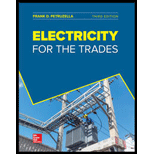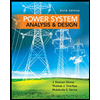
ELECTRICITY FOR TRADES (LOOSELEAF)
3rd Edition
ISBN: 9781260437454
Author: Petruzella
Publisher: MCG
expand_more
expand_more
format_list_bulleted
Concept explainers
Textbook Question
Chapter 1.2, Problem 7RQ
Explain what is meant by an arcing fault.
Expert Solution & Answer
Trending nowThis is a popular solution!

Students have asked these similar questions
5. Consider a Shor who
(4) Skh the impulse repom of the Chor for -5%, a-2+5.
Omie weer de Sher is
drain canal and explain sty
odical, chronic sale of a hat will result in a coal for, and expls why it
Find the inverse Z-transform of X(z) using partial fraction method
X(z) =
z²+Z
Z2-3Z+2
for
i) ROC 12
iii) ROC |z| <1
.The previous solution does not explain the steps
Consider the signal:
f(t) =
글씨를
1
0,
otherwise
Use the Fourier transform formula to find F(w).
Chapter 1 Solutions
ELECTRICITY FOR TRADES (LOOSELEAF)
Ch. 1.1 - Does the severity of an electric shock increase or...Ch. 1.1 - In general, voltage levels above what value are...Ch. 1.1 - In general, current levels above what value are...Ch. 1.1 - What circuit fault can result in an arc flash?Ch. 1.1 - Define each of the following terms associated with...Ch. 1.1 - Explain why an arc flash is so potentially...Ch. 1.1 - What is a permit-required confined space?Ch. 1.1 - What does the term personal protective equipment...Ch. 1.1 - What personal protective attire is required when...Ch. 1.1 - When should face shields be worn?
Ch. 1.1 - A fall arrest system must be rigged so that...Ch. 1.1 - A ladder is used to reach the top of a building 16...Ch. 1.1 - What are the deck requirements for a scaffold work...Ch. 1.1 - Prob. 14RQCh. 1.1 - List the three ingredients required to sustain a...Ch. 1.1 - Which classes of fire are multipurpose...Ch. 1.1 - List four hazardous properties or characteristics.Ch. 1.2 - Prob. 1RQCh. 1.2 - Compare the terms grounding and bonding.Ch. 1.2 - Why is the earth not considered to be an effective...Ch. 1.2 - Explain what is meant by a ground fault.Ch. 1.2 - How does a ground-fault circuit interrupter (GFCI)...Ch. 1.2 - How does a ground-fault circuit interrupter (GFCI)...Ch. 1.2 - Explain what is meant by an arcing fault.Ch. 1.2 - Compare the amount of current that results from...Ch. 1.2 - Compare what GFCIs and AFCIs protect against.Ch. 1.2 - What does a lockout-tagout procedure refer to?Ch. 1.2 - Prob. 11RQCh. 1.2 - A voltmeter is used to verify that no voltage is...Ch. 1.2 - What is the main goal of OSHA?Ch. 1.2 - What is the primary purpose of the rules set forth...Ch. 1.2 - Assume a piece of electrical equipment has been...Ch. 1.2 - How often is the National Electrical Code updated...
Knowledge Booster
Learn more about
Need a deep-dive on the concept behind this application? Look no further. Learn more about this topic, electrical-engineering and related others by exploring similar questions and additional content below.Similar questions
- 1. Find the transfer fucntion, show all steps.arrow_forward6. Determine the type of the filter in the following figure and calculate the cut off frequency fc, show all steps.arrow_forward5. Find the Transfer Function of the following circuit. Prove that it’s a low pass filter, show all steps.arrow_forward
- 2. Find the transfer function, show all steps.arrow_forwardI have this fsk function code: function [x]=fsk_encode(b,s,f0,f1,N,Fs,K) % b= bit sequence vector % s(1)= output level for 0 % s(2)= output level for 1 % N= length of bit sequence % Fs= Sampling frequency y=zeros(1,N*K); %Setup output vector %for each bit calculatee the rando samples for n=1:N for k=1:K t = (k - 1) / Fs; if(b(n)==0) y((n-1)*K+k)=cos(2*pi*f0*t); % pulse=0 else y((n-1)*K+k)=cos(2*pi*f1*t); % pulse=1 end end x=y; %set output end And this is another code that calls the function in order to get the power density spectrum: clc;clear; % EE 382 Communication Systems- Lab 8 % Plots the power spectrum of the ASK modulation % First specify some parameters N=256; % number of bits per realization M=100; % number of realizations in the ensemble T=0.001; % bit duration in seconds delf =2e+3; fc=10e+3; f0=fc-delf; f1=fc+delf; Fs=8*f1; % sampling frequency (this is needed to calibrate the frequency axis) K=(T/(1/Fs)); % Define arrays for bit sequences and sampled waveforms…arrow_forwardCalculate the parameters in the figurearrow_forward
- Write the angle expression form of first null beam width FNBW) for 2/2 dipole. for 즐, 꽃 3arrow_forwardThe circuit is in the DC steady state, So all transients are passed. What are the values of 1 and V, under those conditions. P 24v + + √2 АЛАД 42 4F 3.H ww 22 eee + 203 Varrow_forwardFind the value of Vc (t) for all I That is, the complete response including natural and forced responses.) АДДА 422 OV ДААД t = 0 3F + V(t) -arrow_forward
arrow_back_ios
SEE MORE QUESTIONS
arrow_forward_ios
Recommended textbooks for you
 Delmar's Standard Textbook Of ElectricityElectrical EngineeringISBN:9781337900348Author:Stephen L. HermanPublisher:Cengage Learning
Delmar's Standard Textbook Of ElectricityElectrical EngineeringISBN:9781337900348Author:Stephen L. HermanPublisher:Cengage Learning Electricity for Refrigeration, Heating, and Air C...Mechanical EngineeringISBN:9781337399128Author:Russell E. SmithPublisher:Cengage Learning
Electricity for Refrigeration, Heating, and Air C...Mechanical EngineeringISBN:9781337399128Author:Russell E. SmithPublisher:Cengage Learning Power System Analysis and Design (MindTap Course ...Electrical EngineeringISBN:9781305632134Author:J. Duncan Glover, Thomas Overbye, Mulukutla S. SarmaPublisher:Cengage Learning
Power System Analysis and Design (MindTap Course ...Electrical EngineeringISBN:9781305632134Author:J. Duncan Glover, Thomas Overbye, Mulukutla S. SarmaPublisher:Cengage Learning

Delmar's Standard Textbook Of Electricity
Electrical Engineering
ISBN:9781337900348
Author:Stephen L. Herman
Publisher:Cengage Learning

Electricity for Refrigeration, Heating, and Air C...
Mechanical Engineering
ISBN:9781337399128
Author:Russell E. Smith
Publisher:Cengage Learning

Power System Analysis and Design (MindTap Course ...
Electrical Engineering
ISBN:9781305632134
Author:J. Duncan Glover, Thomas Overbye, Mulukutla S. Sarma
Publisher:Cengage Learning
FMPR-103 pt1 l Power Systems Protection v1; Author: L&D for Protection and Control;https://www.youtube.com/watch?v=ELWncjsh5uE;License: Standard Youtube License